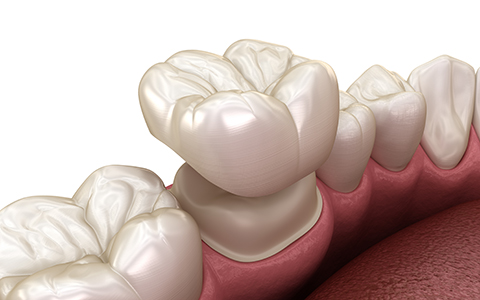Restorative Dentistry
Our goal is to prevent dental problems before they occur. Genetics, infrequent checkups, and other risk factors may lead to poor oral hygiene. Our restorative services are designed to improve the function and aesthetics of your smile, as well as your overall oral health.
Dental Crowns
A dental crown is a tooth-shaped cap that improves the structure and cosmetics of a damaged or decayed tooth. During the procedure, your tooth must be completely reshaped to accommodate the shape of the crown.
Once the tooth is reshaped, we will permanently bond the crown to the enamel using a special adhesive. Many crowns are fabricated these days with porcelain, due to its unmatched aesthetics.

Dental Bridges
A dental bridge is a tooth replacement that typically consists of two dental crowns linked together by a pontic, or false tooth. A traditional bridge is supported by the two surrounding teeth, known as abutment teeth, that we reshape to receive the crowns.
A bridge can also be supported by a series of dental implants if multiple adjacent teeth are missing. If you are missing a tooth, a bridge will prevent the remaining teeth from shifting out of their proper position.
Inlays & Onlays
Inlays and Onlays are ideal for areas of decay too large for a filling, but not large enough to require the placement of a dental crown.
The restoration is considered an inlay if it is placed within the occlusal (bite) surface of a tooth. The restoration is considered an onlay if it extends beyond one or more of the occlusal cusps.
Dental Fillings
Dental fillings are the best way to restore minor to moderate instances of tooth decay. Most fillings these days consist of a material known as composite resin. Composite resin is an aesthetically-pleasing material that we color-match to the existing shade of your enamel.
For this reason, a composite filling is virtually indistinguishable from the rest of your tooth..
Root Canal Therapy
Root canal treatment is a procedure used to repair and save a tooth that is badly decayed before it becomes infected. Additionally, when a tooth is fractured or suffers an exposed nerve, it can be extremely painful. Infection can develop, leading to swelling of the face and other visible symptoms. In these instances, a root canal is required to alleviate symptoms and save the tooth. During the root canal procedure, the nerve is removed from the inside of the tooth or canal, and then the canals are rinsed, cleaned, and sealed. After Root Canal treatment, the tooth should be restored by a crown in most cases.
Are you ready to book an appointment or have questions?
Simply complete our form or call our office .
We look forward to hearing from you.


